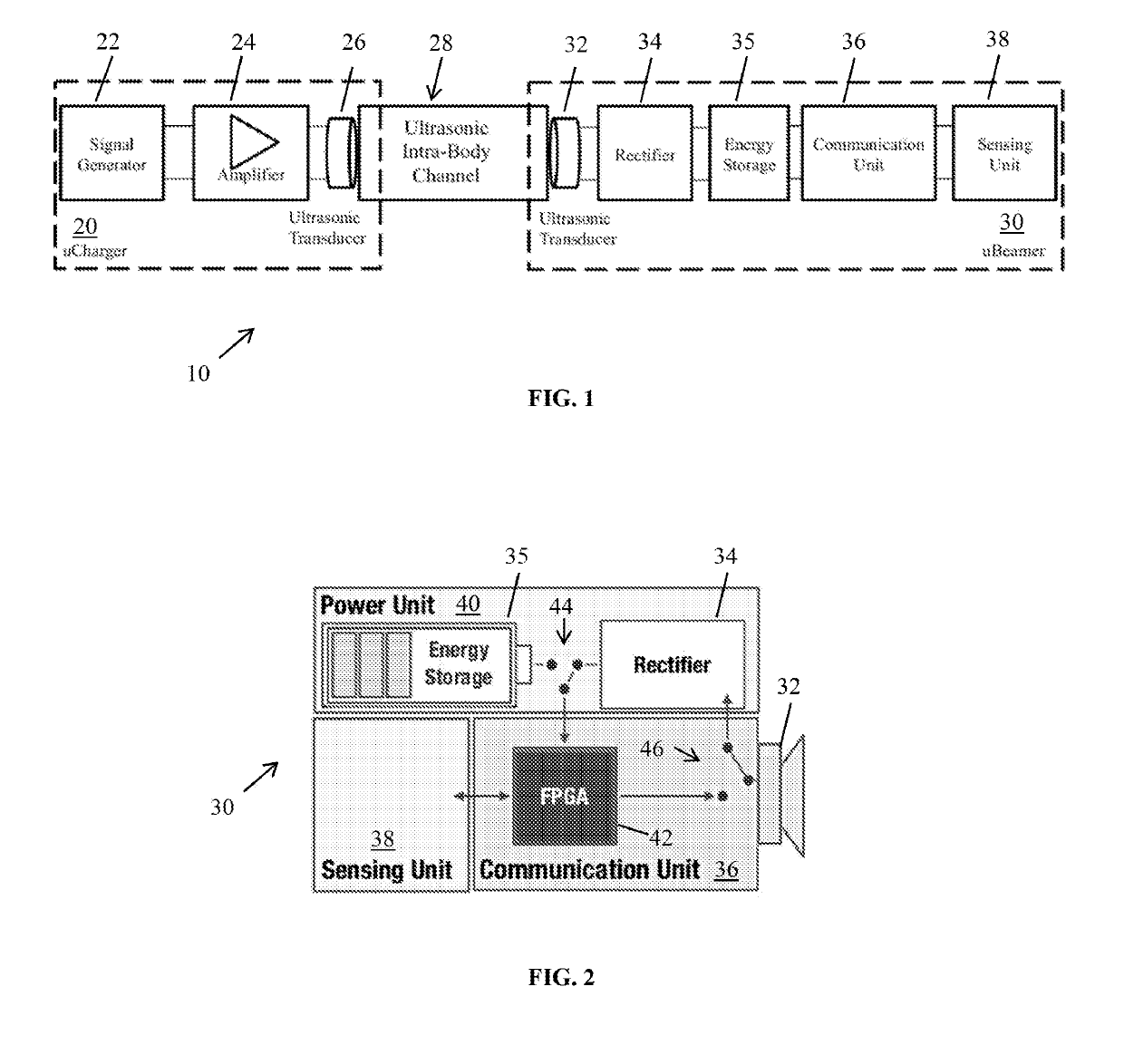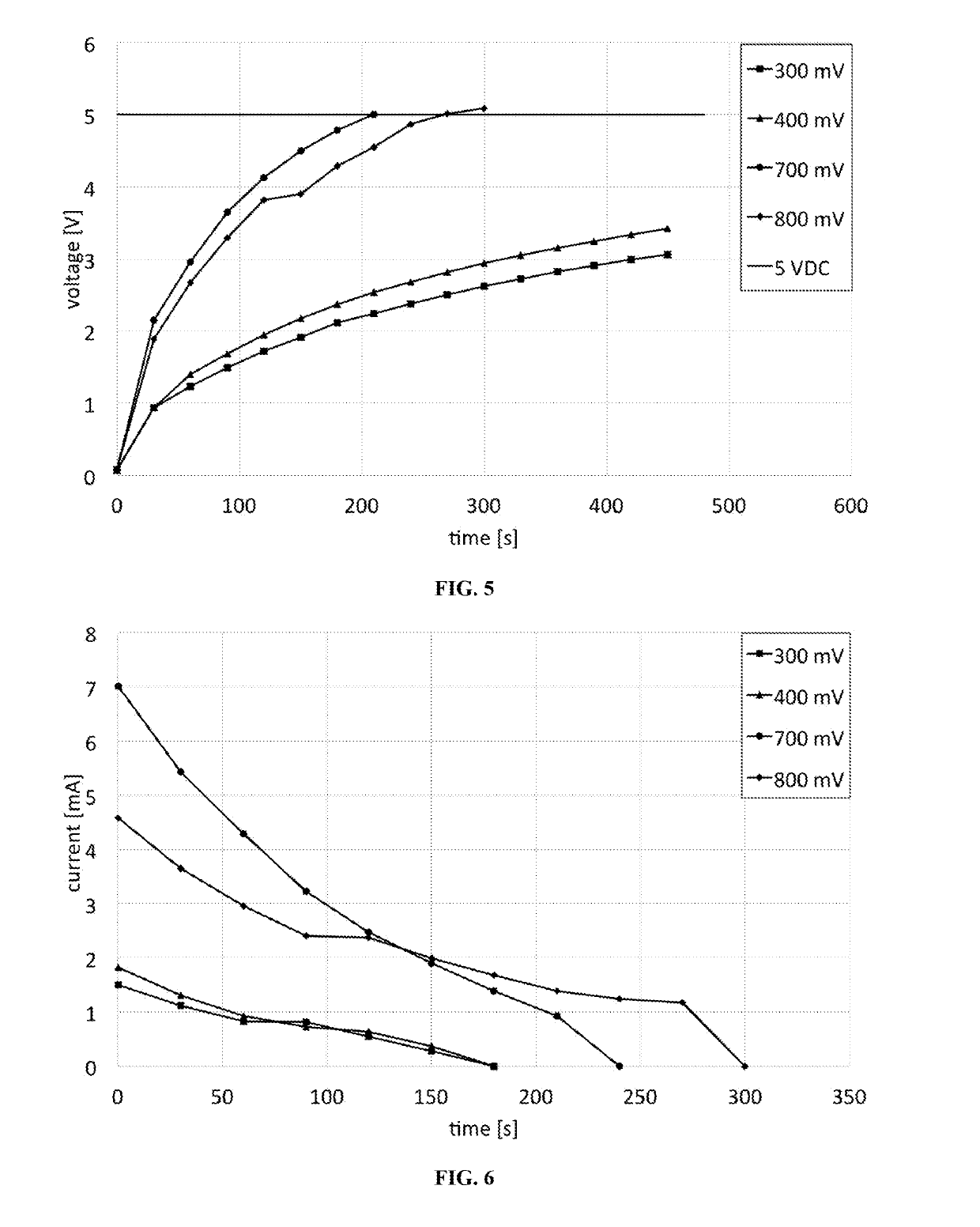Powering implanted
electronic systems is a critical challenge in the area of implantable medical devices (IMDs) [A1] [A2].
Clearly, this is a crucial problem especially for life-saving medical devices like cardiac or neural bio-implants.
In specific cases, depending on the power of the
acoustic wave and the duration of the
exposure, health hazards can arise.
From these curves, it can be observed that increasing the input
voltage to the
system is not always the best strategy to recharge the
capacitor faster.
For lower
voltage values, the charging process can be very slow and take more than 10 minutes to reach the 5 VDC threshold.
In the experiments, cases were examined where the input signal to the rectifying circuit was too small and a useful amount of power could not be conveyed to recharge the
capacitor.
One of the most challenging aspects faced by both traditional systems and futuristic designs is how to power or recharge the device under constraints on
miniaturization while complying with low power levels allowed by the
Food and Drug Administration (FDA).
However, the rate of
sudden death in patients with
cardiac implanted electronic devices (CIEDs) is still high and the physical and mental discomfort of wearing a pacemaker needs to be properly addressed [8].
In addition, to date, several clinical demands, e.g., leadless and endocardial pacing, subcutaneous ICD, and sensing and monitoring of
heart failure, among others, have not received a satisfactory solution yet [27].
Miniaturization, long lifetime, and
wireless networking capabilities are major requirements for a neurostimulator, but they are not completely met by existing and traditional devices.
Unfortunately, investments in early stages of innovation have seen a decline during the last years; conversely, financial support by investors is remarkable during the later stages of the development of a device.
Unique
engineering challenges rise from the highly regulated market of IMDs [30].
This is a vital aspect, since implants can be defective [15] and lead to death in several cases [47].
The embedded electronic circuitry and subsystems require power, which, with
biocompatibility issues, remains one of the major problematics in the design of implantable technologies and hindrance to
miniaturization [6].
Implementing
wireless powering methodologies that could substitute traditional batteries, is challenging, because both good
energy transfer efficiency and high power levels are needed, but achieving them while meeting the FDA recommendations is one of the major difficulties.
Furthermore, using miniaturized components impacts the system performance, since they determine the maximum sustained power, which in some cases is too low.
However, adding function to the system increases the overall energy requirements.
On the one hand, batteries can offer enough energy to power an IMD, such as a pacemaker, for years; on the other, they
pose three fundamental concerns that limit their applicability to IMDs.
Batteries are often too large in size, the materials used in their fabrication can be toxic for human tissues in case of leakages and, finally, once discharged, they have to be substituted through a
surgical operation that entails economical costs, discomfort, and even
death risk for the patient.
The main difficulties in creating an implantable harvester are related to the technology to fabricate the transducer and to the nature of the source.
Electrostatic and electromagnetic (EM)
converters are mechanically complex systems, which makes the miniaturization a challenging process.
After all, in the majority of both
energy harvesting based approaches and TET solutions, the energy cannot be used the moment it is received or harvested.
Therefore, if an electronic circuitry implements the sensing, communication and
data processing properly, but is too large or does not respect the power
exposure limits, it cannot be implanted.
Furthermore, particular miniaturized solutions have to be found for wearable or patch-like devices thought to be attached to the
skin.
These safety limitations translate into design constraints and
impact the
dimensioning of the whole system.
In each of the two conversion process, part of the input power is lost due to non-idealities of the devices.
The disadvantages are the higher number of capacitors and the lower current at the output.
However, having larger DC voltages is desirable in low-
power circuits, because they allow recharging an
energy storage component even when the received AC
voltage is of the order of few hundreds of milliwatts and would not provide enough power with a
rectifier.
The output voltage is directly proportional to n, however there is a limit on the maximum number of stages that can be used, as the conversion efficiency of the circuit is function of n. Higher voltages can be produced in output by increasing n, but the conversion efficiency decreases due to
power loss caused by parasitic effects of the capacitors [33].
Moreover, increasing the number of stages also implies that more components need to be accommodated on the
implant, occupying precious area on the board.
ASICs are designed and permanently configured only for one specific application; hence, they do not provide the flexibility and
reconfigurability required in many cases.
Furthermore, design and fabrication of such systems are highly expensive and
time consuming.
However, FPGAs performance can be from 5 to 25 times worse than ASIC implementations, and operations more complex to define with respect to
microprocessor [19].
In reality, some parasite resistances, non-ideal behavior of the components, and the ESRs of the supercapacitors add up to a small
resistive load.
These values are obtained bearing in mind that the supercapacitors cannot be completely depleted, since when the voltage drops to 2.5 V it is not sufficient to activate the leads.
Systems that use separate technologies for
wireless power transfer and data communication introduce more complexity in the system and require more precious space on the
implant, especially to accommodate capacitive coils or RF antennas in addition to the acoustic transducer that can play the same role.
The
advantage of this principle is that the
implant does not need energy for communication purposes, but the range of applications is limited, and intra-body networking is not possible, unless other nodes provides the power.
 Login to View More
Login to View More  Login to View More
Login to View More 


